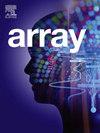Clustering microbial material on agar plates: A modular system approach
IF 4.5
Q2 COMPUTER SCIENCE, THEORY & METHODS
引用次数: 0
Abstract
Analyzing microbial colonies on agar plates is a critical task in microbiology, with applications spanning research, diagnostics, and industry. Despite advances in automated systems, challenges remain in accurately segmenting and clustering colonies due to variability in their appearance and distribution. To address these challenges, we present a fully automated modular system for colony segmentation and clustering, combining state-of-the-art deep learning for segmentation and machine learning for cluster count prediction and clustering.
The main contribution of this work is the proposition, development and evaluation of a novel system, which achieved a V-measure of 0.532 under real-world conditions, improving to 0.727 with ideal segmentation and cluster counts, setting a new benchmark for microbiological analysis. At the core of the system we propose AgarNet, an Attention U-Net-based architecture combined with an EfficientNetB4 backbone, which achieved an F1-score of 0.906 for segmentation. We also introduce a new BRUKERCLUSTER dataset, which is one of the largest and most diverse annotated resources of its kind, featuring expert-annotated images from a controlled cultivation. By combining the dataset, robust segmentation, accurate cluster count prediction, and effective clustering, the proposed system delivers a scalable solution for advancing automated microbial colony analysis.
These results establish a new benchmark for automated colony clustering in microbiology, and by releasing the unique BRUKERCLUSTER dataset, we provide a valuable tool for future advancements in automated colony analysis.
聚集在琼脂板上的微生物材料:模块化系统方法
分析琼脂板上的微生物菌落是微生物学中的一项关键任务,其应用跨越研究,诊断和工业。尽管自动化系统取得了进步,但由于其外观和分布的可变性,在准确分割和聚类菌落方面仍然存在挑战。为了应对这些挑战,我们提出了一个用于群体分割和聚类的全自动模块化系统,将最先进的深度学习用于分割和机器学习用于聚类计数预测和聚类。本工作的主要贡献是提出、开发和评估了一个新系统,该系统在实际条件下的v值为0.532,在理想的分割和聚类计数下提高到0.727,为微生物分析设定了新的基准。在系统的核心,我们提出了AgarNet,一个基于注意u - net的架构,结合了一个高效netb4骨干网,它在分割方面取得了0.906的f1分。我们还引入了一个新的BRUKERCLUSTER数据集,它是同类中最大和最多样化的注释资源之一,具有来自受控种植的专家注释图像。通过结合数据集、稳健的分割、准确的聚类计数预测和有效的聚类,所提出的系统为推进自动化微生物菌落分析提供了可扩展的解决方案。这些结果为微生物学中自动化菌落聚类建立了新的基准,并且通过发布独特的BRUKERCLUSTER数据集,我们为自动化菌落分析的未来发展提供了有价值的工具。
本文章由计算机程序翻译,如有差异,请以英文原文为准。
求助全文
约1分钟内获得全文
求助全文

 求助内容:
求助内容: 应助结果提醒方式:
应助结果提醒方式:


